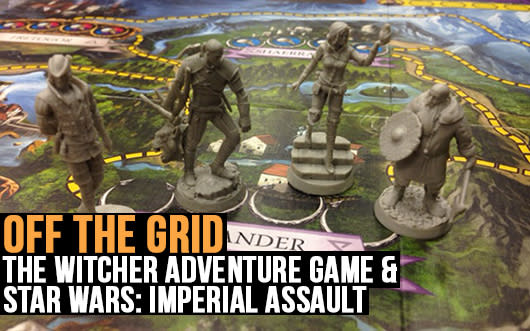Off the Grid: The Witcher Adventure Game and Star Wars Imperial Assault
Like most sci-fi shows on Fox, Off the Grid is getting canceled (we're all saying goodbye, actually).
In this series finale of the board and card game series I had hoped to evolve over time, we're keeping our spirits high with a look at two recent, fantastic releases from publisher Fantasy Flight Games: The Witcher Adventure Game and Star Wars: Imperial Assault.
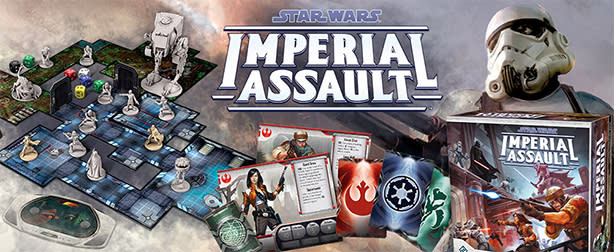
If you watched our XCOM: The Board Game video, you may remember my surprise the adaptation of that strategy game wasn't more in line with a dungeon crawler style board game. Rather than explore corridors made up of modular tiles, that game was more focused on management and decision making within a stressful environment. Star Wars: Imperial Assault is the type of game I expected when I had originally heard XCOM was being adapted into a tabletop experience.
Imperial Assault is the big ticket right now, a light war/adventure miniatures game for up to five players from designers Corey Konieczka (Battlestar Galactica), Justin Kemppainen (Descent 2.0) and Jonathan Ying. Aside from Plaid Hat's Dead of Winter – a board game that continues to be hard to find at a reasonable price – Imperial Assault might be the hardest game to come by in retail stores (though your personal experience may vary).
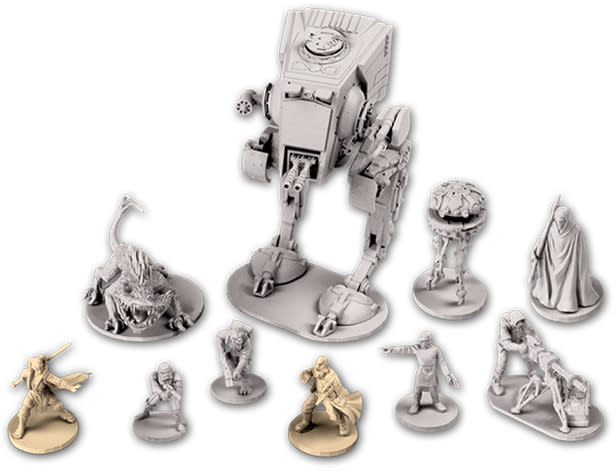
When you crack open the box for Imperial Assault, the experience seems daunting. Within the large, heavy cardboard packaging is four books: two explaining rules in varying levels of detail and two scenario books. Imperial Assault can be played as a campaign game or in quick skirmishes. A campaign game in the Star Wars: Imperial Assault tabletop game works like a video game campaign, you set off on a mission and – based on the result of that mission – you progress to other story missions found within the booklet. There are even side quests that can appear.
The campaign book tells a story that is manageable, interesting and dripping with Star Wars themes. In skirmish matches rebels deploy their characters throughout the board, gaining points for killing adversaries in dice roll battles and accomplishing objectives that appear on the board. Players build their crew from a pool of limited points, without going over. You can add Darth Vader to your team, for example, but he will cost you 18 points out of 40; it's a tactical call, but Vader's abilities make him an attractive ally.
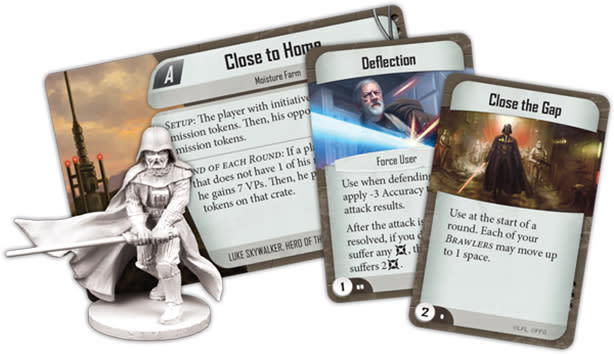
There are far more detailed breakdowns of the rules at BoardGameGeek, but my impression of the game so far is that it's essential for light miniature-based war games. It's a fairly simplistic to play, but the campaign booklet offers a lot of surprise on par with a choose-your-own-adventure. Missions can go awry and sudden changes can put you in the path of new and interesting characters, or some old favorites. Players move their units around the board, exhausting abilities and venturing toward objectives or to attack. Imperial Assault has a great line of sight feature where you measure the distance between the squares separating two attacking characters and, so long as nothing blocks your view, you can proceed with a strike using a series of dice.
I'm not much of a Star Wars aficionado, but even I appreciated how drenched in theme Imperial Assault was. The components are stunning. The miniatures are detailed and beautiful – something Fantasy Flight excels at. It seems the game will be fresh over multiple playthroughs based on the malleable nature of so many systems. The board is modular, the characters included are vast and more are coming in expansions, the skirmishes are randomized and exciting and the campaign keeps you on your toes with new and interesting events. Imperial Assault is worth your attention.
From lighthearted sci-fi fantasy to gritty mature fantasy, Fantasy Flight also publishes The Witcher Adventure Game, a fantasy adventure for up to four players. From designer Ignacy Trzewiczek (Robinson Crusoe: Adventure on the Cursed Island), The Witcher board game sees players on the same side compete for points. You don't battle each other, instead you venture throughout the world completing quests and defeating enemies for rewards. Though the game's art is based in the Witcher video game universe, its story and themes are similarly adapted from the franchise's novels. There are four playable characters, each with their own attributes and special ability: Geralt, The infamous monster-hunting Witcher; Dandelion, the thief; Yarpen, the battle-hungry dwarf; and Triss, the powerful mage.

Each character comes equipped with its own development deck. Much like a video game RPG, players tech out their characters with the deck and go out into the world to investigate events, complete quests and battle waves of enemies. While players will fight for victory points and the majority of them will come by way of completing quests, players can collect a number of points by focusing on side quests, combat and more.
There's even incentive to work together in some instances, where some quests will offer rewards to other players if they help you to complete your goals. When a player completes their third quest (or fifth in an epic game), each player can make one more turn before final victory points are totaled.
For a detailed breakdown of the rules and how The Witcher Adventure Game plays, make sure to watch CD Projekt Red's video tutorial.
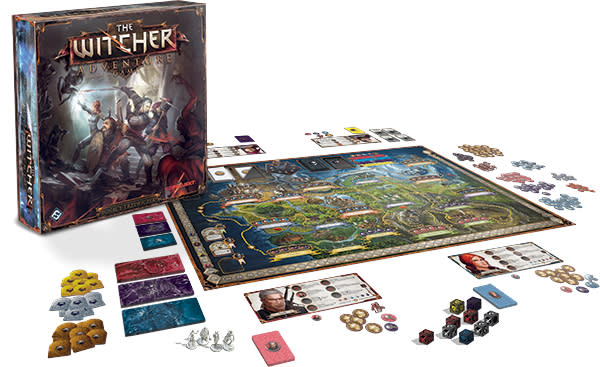
The Witcher Adventure Game has shades of a racing game. Players will plot their journey around the board, which is a static map, to rush toward cities with investigation pieces and quest markers. Each player has vastly different styles. Geralt is a fighter, but he is also a strategist. His ability allows him to meditate and develop potions for the journey ahead. Dandelion is cunning and can bribe enemies or call on powerful allies to aid him in a fight. It's not only combat-based, however. You can choose to be diplomatic, sly or aggressive. Your choices affect your rewards and thus your progression, similar to the video game franchise.
In moments, The Witcher Adventure Game reminds me of Relic – a 2013 standout tabletop game that focuses on exploration and adventure in the Warhammer 40,000 universe. But the aesthetic of The Witcher Adventure Game, sharing art with one of my favorite RPG video game franchises, and its themes that line up with the dark stories that unfold in the games and novels put Trzewiczek's new board game on the top of my must-play heap at the moment.
With so many quests and varying characters, The Witcher board game offers a lot of variety. Play styles can alter your story and change your character progression. Quests can be surprising and difficult, but reward you for your effort. The Witcher Adventure Game is a new personal favorite tabletop experience.
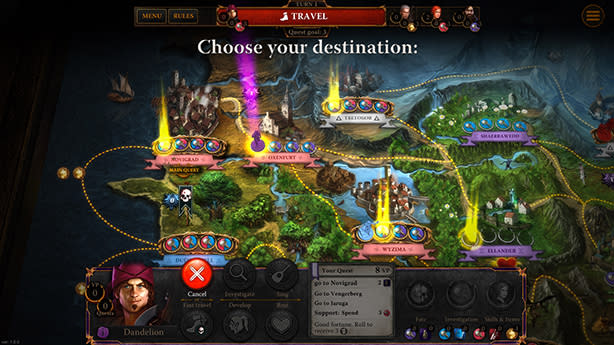
What's interesting about The Witcher Adventure Game is that it's available as a board game with Fantasy Flight's standard crop of gorgeous components, or as a video game. I don't mean The Witcher video games, I mean a PC, Mac and mobile devices adaptation of the board game. I prefer the interaction of the board game, but the video game is a terrific adaptation. It's almost as if a video game developer was already involved in the making of the board game!
My wish for Off the Grid would have been to have new videos of myself and friends playing, enjoying and discussing tabletop games. Sadly, that isn't in the cards here, so words will have to suffice. If you're looking to add two amazing games to your tabletop collection – two that have strong ties to the video game world – Star Wars: Imperial Assault and The Witcher Adventure Game are worth your time and money.
Thanks for playing and catch more tabletop love on my YouTube channel, going forward!
[Images: Fantasy Flight Games, CD Projekt Red]
